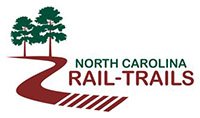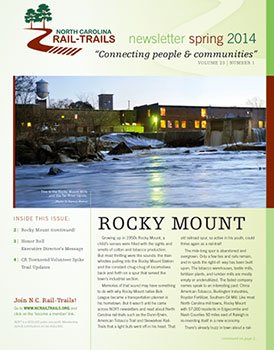Appeals Court upholds full trail rights
In August 2006 North Carolina's Court of Appeals unanimously affirmed a decision of a Rutherford County trial court which could help in establishing future rail--trails in North Carolina. The ruling found that the Rutherford County Thermal Belt Rail-Trail was held by defendant Bechtler Corporation, the nonprofit trail owner, in full ownership and not merely as an easement. The plaintiffs did not appeal the ruling up to the state Supreme Court and the decision stands as precedent. As a consequence the adjoining landowners have no interest in the subsurface or aerial rights so as to collect fees from utilities, including revenues for possible fiber optic lines. The trail was represented Bailey and Dixon, LLP, by David S. Coats and Michael Domonkos, the latter appearing as “of counsel.” Both attorneys are on the Board of North Carolina Rail-Trails. Domonkos said that the plaintiffs at the trial level had originally challenged whether the trail had been properly railbanked under the federal program designed to protect abandoned rail corridors for possible future rail use. The program permits interim conversion to trails for recreation and non-motorized travel. The adjoining landowners gave up on the railbanking challenge but argued that they were the fee owners and that the rail-trail was an easement limited to trail uses. The plaintiffs argued that even if there was proper railbanking, they were entitled to a declaratory judgment which would give them ownership of revenues derived for any fiber optic cables placed in the rail bed and damages for utility, sewage and other encroachments which allegedly had been wrongfully permitted by the trail owners and former railroad companies. Rutherford County Superior Court Judge Laura J. Bridges held June 28, 2005, that the predecessors to the defendant Bechtler Corporation obtained the rail bed outright and not not just by easement. The plaintiffs disagreed with the decision and appealed to the state Court of Appeals. The original title obtained in 1855 provided that the railroad owned the property "so long as" it was used for purposes of the railroad. North Carolina statutes in 1973 voided such old and remote limitations unless the adjoining landowners timely file notice to preserve such limitations. For old deeds, the filing had to by October 1, 1976. There was no such filing by the plaintiffs. Domonkos predicted that the decision would be a significant precedent. It could provide helpful to establishing rail-trails on rail beds long thought to be abandoned and lost. He said :“…take another look at those old deeds and transfers to the railroads”. The importance of this ruling is that it is similar to rulings in many other states which hold that a limitation in a deed to "railroad purposes" or “so long as it is used for railroad use” and similar language does not create a mere easement but nearly full ownership by the railroad which ripens into full ownership after the statutory period. The court also affirmed that use of the term “right of way “ in a deed is neutral term and could mean a fee interest or an easement. Domonkos believes that in North Carolina a significant number of rail beds thought to having been easement and thus having been reverted to adjoining landowners may actually still be viable for future rail use or conversion to trails. It has been held in North Carolina that if the railroad owns the property in fee, no adverse possession or encroachment by adjoining land owners or others will divest the railroad of ownership, no matter how long the absence of railroad use and the railroad's failure to police its property. In short, there are no “squatter’s rights” against a railroad. For further commentary see our Fall 2006 Little Toot article.
Support NCRT

North Carolina Rail-Trails is a proud member of Earth Share of North Carolina. Look for us in your workplace giving campaign.



